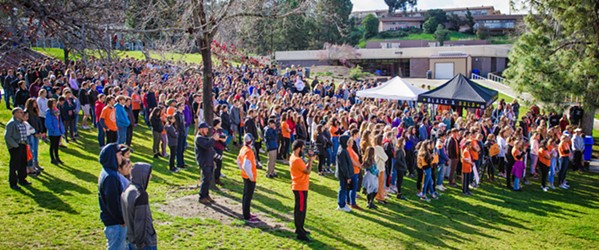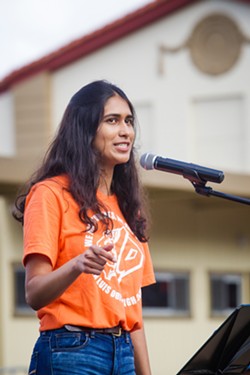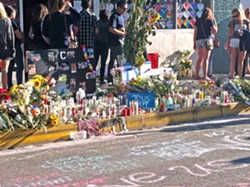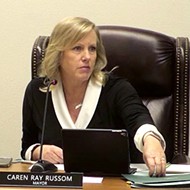#Enough: Local students protest gun violence, face threats, and shelter in place in the wake of Florida high school shooting
By Camillia Lanham[{
"name": "Ad - Medium Rectangle CC01 - 300x250",
"id": "AdMediumRectangleCC01300x250",
"class": "inlineCenter",
"insertPoint": "8",
"component": "2963441",
"requiredCountToDisplay": "12"
},{
"name": "Ad - Medium Rectangle LC01 - 300x250",
"id": "AdMediumRectangleCC01300x250",
"class": "inlineCenter",
"insertPoint": "18",
"component": "2963441",
"requiredCountToDisplay": "22"
},{
"name": "Ad - Medium Rectangle LC09 - 300x250",
"id": "AdMediumRectangleLC09300x250",
"class": "inlineCenter",
"insertPoint": "28",
"component": "3252660",
"requiredCountToDisplay": "32"
}]
As Paso Robles students at four different schools sheltered in place on March 20, law enforcement officers searched for a gun that was supposedly hidden somewhere on or near Paso Robles High School campus.
It was a "precautionary measure," according to the Paso Robles Joint Union School District.
Three Atascadero schools faced a similar shelter in place order on March 14. It was the day students across the nation planned to walk out of class to protest school shootings and honor the 17 students and teachers who were killed the month before in a school shooting in Parkland, Florida. The Atascadero Police Department was notified that morning of a threat made the day before in an Instagram post: "I'm shooting up the school tomorrow during the walkout. Are you?"
That same day, students at Ernest Righetti and St. Joseph high schools in Santa Maria also faced a shelter in place order due to perceived gun threats to the school that turned out to be related to Atascadero. A social media gun threat to Poly High School in Long Beach put Cal Poly on alert Feb. 21, and earlier that week, Santa Maria High School went on lockdown because of a gun threat posted on Snapchat.
All of this happened after a 19-year-old shot up Marjory Stoneman Douglas High School on Feb. 14 with an AR-15 and the wave of activism that followed. In the midst of attending funerals, high school students and parents crashed town halls and the Legislature in Florida, calling out U.S. Senators and Representatives, the National Rifle Association (NRA), and state elected officials for doing nothing to prevent the deaths of hundreds of students since the 1999 shooting at Columbine High School in Colorado. The 17-minute Enough! National School Walkout marked the one-month anniversary of that day. The pressure mounted by those students has forced some change in Florida.
The goal of the movement is to keep that pressure high, forcing gun laws to change at the national level. On March 24, the Women's March SLO is organizing a March for Our Lives protest that starts in Mitchell Park, joining a nationwide demonstration that will "send a message to Congress that they must act now" to prevent gun violence in schools and mass shootings across the nation.
Potential threats of gun violence leveled at local high schools didn't stop students who wanted to protest on March 14 from doing so. Students from Paso Robles to Santa Maria still managed to hold up signs saying they'd had enough, advocating for change to gun laws, and warning the world that they will be voting in the 2020 election.
The quad was packed at Arroyo Grande High School starting around 10 a.m., according to Casey Crouch, president of the school's Young Progressives club. He estimated that between 300 and 400 students showed up to participate, listening to short speeches and songs, and ending the event by joining together to sing "Imagine" by John Lennon.
"We're happy to say that the administration was completely supportive of the walkout," Crouch wrote in an email to New Times. "As a nation, we can't stop speaking out on this issue until significant legislation is passed and the rate of firearm-related deaths decreases."
Restraining violence
The anguish of rehashing your child's death over and over again is a pain that's hard to imagine. And yet, parents whose children are victims of mass shootings roam the halls of Congress and state legislatures doing exactly that. Repeating the tale that ended with a life—their child's life—taken. Advocating to elected representatives. Hoping that it will result in legislation to prevent future gun deaths.
"They want their children's death to have meaning," said Das Williams, who served in the state Assembly from 2010 to 2016 and currently sits on the Santa Barbara County Board of Supervisors. "They don't want others to go through the anguish that they have. And I really think that they are very brave, especially those who have walked the halls of state legislatures trying to pass these policies."
Under pressure, Florida Governor Rick Scott signed a bill into law on March 9 that raises the minimum age to purchase a firearm from 18 to 21, bans the sale of bump fire stocks, gives law enforcement more power to take weapons and ammunition from people deemed mentally unfit, allocated additional funding for armed school resource officers, and allows teachers to be armed if approved by the school district and sheriff's office.
The incident in Florida renewed the effort behind a bill introduced by U.S. Rep. Salud Carbajal (D-Santa Barbara) last May that would allow gun violence restraining orders. Although his bill had only partisan backing in 2017, at least five House Republicans announced their support for the measure after the Feb. 14 shooting in Parkland. Sen. Lindsey Graham (R-South Carolina) introduced a comparable bill in the Senate with a Democratic colleague.
Gun violence restraining order laws are already in place in states like California. They operate similarly to domestic violence restraining orders. Immediate family or law enforcement can request a temporary court order that prohibits the person in question from possessing or receiving any firearms if a judge believes them to be an immediate danger to themself or others.
"From mass shootings to suicide, what this bill does is it tries to allow family members and law enforcement to work with the court ... to assess individuals who are a danger to themselves or others," Carbajal said. "I know too well and am familiar with these tragedies. My older sister, when I was young, committed suicide with my father's firearm."
Carbajal was also a Santa Barbara County supervisor in May 2014, when a 22-year-old Isla Vista man shot and stabbed six UC Santa Barbara students to death, injured several others, and eventually killed himself.
"I think it affected me like the rest of the community. It was a tragedy. It was shocking that somebody in crisis—the family reached out to law enforcement and they had no tools," Carbajal said. "It really motivated me to see what I could do to pass laws that might enhance the tools."
California's gun violence restraining order was one of the results of parents who'd lost children to that shooting putting pressure on elected officials. Co-sponsored by Williams, it was one of the first laws of its kind in the United States. Governor Jerry Brown signed the bill in September 2014, and the law took effect starting in January 2016.
"I do think that it helps and I don't think that pro-gun politicians should view this as taking away guns. ... I think, honestly, more people are going to be saved by this legislation that were suicidal rather than homicidal," Williams said. "It's just not good to have that temptation with you all the time. It doesn't have to be a permanent thing. ... A lot of people get through their depression or their mental illness with help and move on to live normal lives."
Prevention tool
California courts utilized gun violence restraining orders 190 times in 2016 and 2017; 21 of those originated in Santa Barbara County, according to state Department of Justice statistics. San Luis Obispo County has used it once in that time.
"We had 11 percent of the GVROs [gun violence restraining orders] in that two-year period and we had only 1 percent of the state's population. So that gives you an idea of how often we use it," Santa Barbara County Sheriff Bill Brown said. "Most people who are mentally ill aren't violent and are more likely to become victims of violence and we have to be careful not to stigmatize people who are mentally ill, but if someone is suffering from a severe mental illness and is exhibiting some sociopathic or self-destructive behavior, it's obviously not a good thing for them to have access to firearms."
In 2016, the Santa Barbara County Sheriff's Office utilized it in cases of domestic violence, potential suicide, and mental health crisis. The discussion about guns and gun control in America is controversial, Brown said, but one thing that people agree on is that people suffering from a mental health crisis, criminals, and people who are a danger to themselves or others shouldn't have access to guns. The new law is a vital tool, he said, to protect the community and potentially reduce homicide and suicide rates.
Michelle Warner from the newly formed San Luis Obispo chapter of Mothers Demand Action said awareness and education have a lot to do with low use of the law in places like SLO County, which is why she is focused on getting the word out about it.
"It's a relatively new law. A lot of people don't know about it, so it's not used a lot," Garner said. "We're working hard to make sure people know it's an option. Just to get it out there to people, so that it is in the back of their head. ... We're fighting really hard to get this passed in all states, because it is really effective."
Garner first looked into joining Moms Demand Action last year. She signed up for text and email alerts, eventually volunteering to become a chapter leader once she realized there weren't a lot of events being held in the area. As she's become more educated about gun violence, she said she's realized how much it affects us.
"It's so much more widespread than I previously assumed. It's not just school shootings," Garner said. "There's a really high correlation between gun violence and domestic violence. Most murder by gun that's committed in this nation is intimate partners."
According to the National Coalition Against Domestic Violence, a gun in a domestic violence situation increases the risk of homicide by 500 percent. Data presented at a U.S. Department of Justice panel on the intersection of firearms and domestic violence in December 2016 showed, "when laws are in place that restrict abusers from purchasing guns, there is an associated decrease in intimate partner murders" that ranges between 7 and 19 percent.
School shootings, though, were the big impetus behind Garner's decision to join Moms Demand Action. She has twin boys in kindergarten and her husband is a teacher, so she wanted to do everything she could to keep her family—and everyone else in the area—safe.
In addition to advocating for and spreading the word about gun violence restraining orders, she said the organization is pushing for California to pass a bill requiring people to go through live fire training before receiving a concealed-carry permit. The goal is uniformity, because although counties like SLO require residents to attend classes to get a the permit, not all of the state's counties do. At the national level, the organization is pushing for background checks to accompany every gun sale (whether it's at a gun show, a shop, or off Craigslist). On the education front, Moms Demand Action puts on Be Smart for Kids workshops to educate parents about gun safety, such as keeping guns in the house locked away and unloaded.
The SLO chapter had its first meeting on March 10, and around 100 people showed up. Garner was floored by the turnout. She said people are starting to realize: The same thing that happened in Parkland, Florida, could happen in SLO.
"We have this false sense of security that SLO is this safe town," she said. "It could happen here."
Safety measures
In light of what could happen in SLO County, a working group that includes the SLO County Sheriff's Office, fire department, public health, and city representatives decided about three years ago to turn grants from the Department of Homeland Security into preparation, precautions, and training that gets all emergency response agencies in the county on the same page when it comes to active shooter events.
The Sheriff's Office utilized more than $100,000 of those funds to map out every school campus in the county and put them in a central database that's accessible to each emergency responder in the county. That way if the Paso police respond to an emergency situation at a school in Atascadero, they already have the specifics they need to respond.
"We push them out to all the police departments for them to have them on their computers in their cars," Sheriff Ian Parkinson said. "Our job is to get all of the responding units to a specific location. ... And once they get on scene, they will have a clear understanding of what that school looks like and what the response will be."
In addition, the Sheriff's Office spent $400,000 in grant money on training equipment that can be used by any law enforcement agency in the county. A 360-degree use-of-force simulator can put police officers and deputies through a variety of situations, including school shootings and how the chaos of those scenarios can change on the fly. The sheriff also invested in iCombat laser guns and vests that enable agencies to train virtually anywhere.
The last leg of that grant funding (approximately $100,000) is being spent on a phone application that will be piloted at Nipomo, Coast, and Templeton high schools this spring. The Rave Mobile Safety app can be installed on all faculty and staff members' phones at each school, it's geo-fenced around the site, and the main feature is an active shooter button.
Messages get shot to everyone else's phone at the school and the nearest law enforcement dispatch center via the app. A school can initiate lockdown procedures and each person with the app knows exactly where the situation is occurring.
"Having an immediate location of the person who's reporting it is vital to us, because we've got to get to that spot," Parkinson said. "We can get straight to that location as quickly as possible."
Recently, all the county superintendents got together with Sheriff's Office officials to talk about response and precautions districts and schools could take to help prevent active shooter situation like this from happening in the future.
"It was a 2.5-hour discussion about safety and where we are with our responses and stuff, and not just reactive, but proactive," SLO County Office of Education Superintendent James Brescia said, adding that because of Diablo Canyon Power Plant, county schools and law enforcement are already pretty coordinated. "We're kind of unique, we're the last county—good or bad—with nuclear power, with that joint communication."
Every superintendent in the county is on the same page when it comes to getting uniform safety and response protocols in place. Brescia said the same goes for allowing students the space and time to have an opinion and participate in events such as the March 14 walkout. Some student groups even brought in information to register other students to vote.
Lucia Mar Unified School District Superintendent Raynee Daley was at Arroyo Grande High School during the student walkout. She said it was successful because it was respectful and gave students the chance to express themselves, whether they chose to participate or not.
"I think it was an educational opportunity for us to provide a venue for them to really think about how would they express their voice and provide a venue for those that were perhaps of an opposite opinion to demonstrate a respect for a differing opinion," Daly said. "And I think we achieved that."
To have all seven cities and the county united as one when it comes to educational opportunities and emergency response protocols is unique to SLO County, Sheriff Parkinson said. Schools are discussing how to catch situations and students before crisis. Talking about what the early indicators are—whether it's childhood trauma, drugs and alcohol, or mental illness—and how to provide the right kind of help.
"I've seen a huge evolution with the superintendents of the schools, that they are really coming together on this issue and trying to come up with universal plans of trying to deal with this situation," Parkinson said. "Unfortunately, I think we all wish that these were anomalies that didn't occur often, but it seems like they're occurring more often and they aren't anomalies. ... I think these things are going to continue to happen." Δ
Editor Camillia Lanham can be reached at [email protected].
Murky numbers
When it comes to addressing the issue of school shootings, nailing down the statistics of just how often they happen is as fraught as the debates over how to prevent and stop them.
The FBI collects data about “active shooter” incidents. The agency defines an active shooter as “any individual actively engaged in killing or attempting to kill people in a populated area”.
According to the FBI’s data, there have been 220 active shooter incidents in the U.S. between 2000 and 2016, resulting in 1,486 dead or wounded. That same data showed that the number of casualties in such incidents rose dramatically over the same period of time, from just seven in 2000, to 212 by 2016.
The same data shows that nearly 22 percent of the active shooter incidents that occurred during that 16-year period took place at educational institutions. Twice as many of those shootings took place at K-12 schools than at institutions of higher learning like universities or colleges.
But the FBI isn’t the only one tracking school shootings, and other organizations claim that there are far more than what the agency has reported. It all depends on how you define a “school shooting.” Everytown for Gun Safety, a nonprofit advocacy group that tracks gun violence in America, stated that there have been at least 305 school shootings in America between 2013 and 2018, far more than what the FBI reported. That’s because the group’s definition of what constitutes a school shooting is far broader.
“Consistent with expert advice and common sense, Everytown uses a straightforward, fair, and comprehensive definition for a school shooting,” the Everytown website states. “Any time a firearm discharges a live round inside a school building or on a school campus or grounds, as documented by the press and, when necessary, confirmed through further inquiries with law enforcement or school officials.”
That means the 300-plus school shootings the group reported included events where someone discharged a gun in school without the intent to harm or kill anyone. Everytown’s definition would include the incident in March when a teacher in the Monterey County town of Seaside discharged his gun into the ceiling of his classroom, injuring three students with falling debris. The incident would not, however, meet the FBI’s definition of an “active shooter,” and thus not be included in the agency’s statistics.
Everytown reported 32 incidents thus far in 2018 that met it’s definition.
“When it comes to American children being exposed to gunfire, these shootings are just the tip of the iceberg,” the organization’s website states.
—Chris McGuinness
Latest in News
Comments (3)
Showing 1-3 of 3
Readers also liked…
-

Coast Unified teachers upset over new position's salary and qualifications
Oct 20, 2022 -

SLO police identify alleged driver who hit and killed couple
Dec 22, 2022 -

When the levee breaks: Oceano residents, county officials walk a tightrope of regulations to manage Arroyo Grande Creek, which some say led to the levee's failure in January
May 18, 2023












